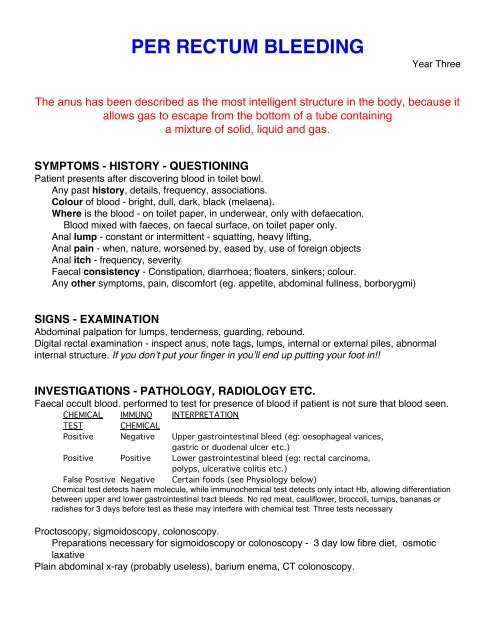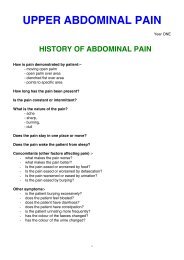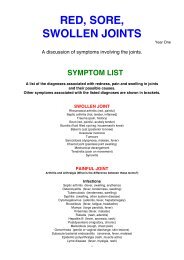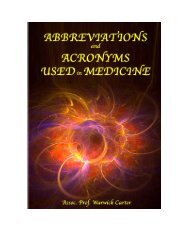MW_S_Lectures_files/PER RECTUM BLEEDING.pdf
MW_S_Lectures_files/PER RECTUM BLEEDING.pdf
MW_S_Lectures_files/PER RECTUM BLEEDING.pdf
Create successful ePaper yourself
Turn your PDF publications into a flip-book with our unique Google optimized e-Paper software.
<strong>PER</strong> <strong>RECTUM</strong> <strong>BLEEDING</strong>Year ThreeThe anus has been described as the most intelligent structure in the body, because itallows gas to escape from the bottom of a tube containinga mixture of solid, liquid and gas.SYMPTOMS - HISTORY - QUESTIONINGPatient presents after discovering blood in toilet bowl.Any past history, details, frequency, associations.Colour of blood - bright, dull, dark, black (melaena).Where is the blood - on toilet paper, in underwear, only with defaecation.Blood mixed with faeces, on faecal surface, on toilet paper only.Anal lump - constant or intermittent - squatting, heavy lifting,Anal pain - when, nature, worsened by, eased by, use of foreign objectsAnal itch - frequency, severityFaecal consistency - Constipation, diarrhoea; floaters, sinkers; colour.Any other symptoms, pain, discomfort (eg. appetite, abdominal fullness, borborygmi)SIGNS - EXAMINATIONAbdominal palpation for lumps, tenderness, guarding, rebound.Digital rectal examination - inspect anus, note tags, lumps, internal or external piles, abnormalinternal structure. If you don’t put your finger in you’ll end up putting your foot in!!INVESTIGATIONS - PATHOLOGY, RADIOLOGY ETC.Faecal occult blood. performed to test for presence of blood if patient is not sure that blood seen.CHEMICAL IMMUNO INTERPRETATIONTEST CHEMICALPositive Negative Upper gastrointestinal bleed (eg: oesophageal varices,gastric or duodenal ulcer etc.)Positive Positive Lower gastrointestinal bleed (eg: rectal carcinoma,polyps, ulcerative colitis etc.)False Positive Negative Certain foods (see Physiology below)Chemical test detects haem molecule, while immunochemical test detects only intact Hb, allowing differentiationbetween upper and lower gastrointestinal tract bleeds. No red meat, cauliflower, broccoli, turnips, bananas orradishes for 3 days before test as these may interfere with chemical test. Three tests necessaryProctoscopy, sigmoidoscopy, colonoscopy.Preparations necessary for sigmoidoscopy or colonoscopy - 3 day low fibre diet, osmoticlaxativePlain abdominal x-ray (probably useless), barium enema, CT colonoscopy.
POSSIBLE DIAGNOSESBRIGHT BLOODPiles [haemorrhoids] (pruritus, discharge, pain)Fissure in ano (pain, constipation)Anal carcinoma [rare - incidence 1.3 per 100,000 people]Rectal carcinoma (tenesmus)Intestinal foreign bodySalmonellosis (copious diarrhoea)Peutz-Jegher syndrome (pigmented mouth and fingers)DULL BLOODColonic carcinoma (variable bowel habits)Ulcerative colitis (colic, diarrhoea, mucus)Colonic polyposis (painless)Diverticulitis (diarrhoea, abdominal pain)Amoebiasis (diarrhoea, colic)Endometriosis (variable blood flow, female, dysmenorrhoea)Crohn disease (abdominal mass, pain, diarrhoea)Infective colitis (fever, malaise, diarrhoea)MELAENAPeptic ulceration (epigastric pain and tenderness)Drugs (eg. nonsteroidal anti-inflammatory drugs, aspirin)Oesophageal or gastric carcinoma (fullness, pain, anorexia)Small intestinal tumours (pain, nausea)Portal hypertension (hepatomegaly)Nose bleedIntestinal lymphoma or leiomyomaCowden disease (stomach hamartomas)Cronkhite-Canada syndrome( abnormal hand and foot pigmentation)Gardner syndrome (sebaceous cysts, colonic adenomas)Diet of dark foods (eg. beetroot) or medications (eg. charcoal) that may be mistaken for blood.VARIABLE BLOOD PATTERNDrugs (eg. warfarin, salicylates)Defibrination syndrome (generalised excessive bleeding)Henoch-Schönlein syndrome (purpura, abdominal pain)Vascular malformations in intestine.Haemophilia and other coagulopathies
SIMPLIFIED EXPLANATION OF PILE FORMATIONADDITIONAL INFORMATIONCOLONOSCOPYA colonoscopy is an examination of the large bowel or colon using a colonoscope, which is aflexible tube which combines the features of magnification and illumination. It is two metres longand enables the doctor to view the entire colon.For the lower third of the colon, an instrument called a sigmoidoscope may be used, which isrigid but shorter than the colonoscope and enables an examination of the bowel for polyps,tumours and other diseases. The instrument used for seeing inside the rectum and anus is called aproctoscope.Before having a colonoscopy, the patient will be given a laxative or an enema and then beinstructed to drink only clear fluids for the day before the test is performed. A solution (eg. sodiumphosphate) must also be drunk in the day before the test to thoroughly cleanse the bowel. It is
unusual to feel any discomfort during the procedure as an effective sedative is given. Theexamination takes about an hour, and any polyps found will be removed during the procedure.As with any procedure, there are risks. Perforation of the bowel may occur in about one in every2000 procedures, and this will require an open operation to close the hole. Bleeding into the bowel,particularly after the removal of a polyp, is another rare complication. Even in the bestcircumstances, about 5% of cancers present will be missed. One in every 16000 patients die fromthe complications of a colonoscopy.COLORECTAL CANCERColorectal cancer is cancer of the large bowel, which forms the last two metres of the intestine.The absolute cause is unknown, but a low fibre and high fat diet may be a factor and there is adefinite family tendency. It is more common in men, and most develop in the last 10 cm of the gut.Finding polyps on a routine colonoscopy or CT scan, ulcerative colitis and chronic bowel infectionsare also risk factors. Any polyps found are always removed to prevent them from becomingcancerous.Screening for colorectal cancer can be done by performing a colonoscopy every five years overthe age of 50 in all those at high risk, and by testing the faeces on at least three occasions for thepresence of blood on all those who wish to have the test.Symptoms include alteration in normal bowel habits, passing blood with the faeces, weight loss,colicky pains in the abdomen and constant tiredness. A large cancer can be felt as a hard lump inthe abdomen. If left untreated, a gut obstruction, or perforation, which allows faeces to leak into theabdomen and causes peritonitis, will occur.A colonoscopy and/or barium enema x-ray will confirm the diagnosis. Blood tests may showanaemia due to the constant slow leaking of blood from the cancer. People with a bad familyhistory can have a faeces sample tested for blood.Treatment involves major surgery to remove the cancer, the bowel for some distance above andbelow the cancer, and the surrounding lymph nodes. Up to 3% of patients may die during orimmediately after surgery. Chemotherapy (drugs - eg. levamisole, tegafur, uracil) and radiotherapymay also be used. Regular examinations of the colon are then required lifelong to detect anyrecurrence.If the cancer has not spread away from the large intestine, two out of three patients will survivefor more than five years, and are probably cured as most recurrences occur within four years. If thecancer has spread, the survival rate drops steadily, depending on the degree of spread.Colorectal cancers are staged by the Dukes system thus -Stage A - Cancer limited to lining of gut - over 95% cured.Stage B1 - Cancer extends into muscle surrounding gut - about 85% cured.Stage B2 - Cancer extends through full thickness of gut wall - about 80% cured.Stage C - Cancer has spread to surrounding lymph nodes in the pelvis - cure rates vary from35% to 60%.Stage D - Cancer has spread to distant organs (eg. liver, lung) - less than 10% cured.Cancers closer to the anus are more difficult to treat and more likely to result in colostomy.CROHN DISEASECrohn disease (regional enteritis) is a chronic inflammation and thickening of the wall of theintestine that usually occurs in the lower part of the small intestine (ileum), but may occur anywherebetween the stomach and the anus. It usually affects young adults, and despite treatment, oftencontinues for the rest of the patient's life. When the intestine of these patients is examined atoperation, segments of bowel from a few centimetres to a metre or more in length are found tohave a wall that is several times thicker and much firmer than normal. It may vary from a minor
irritation to being a very serious disease as patients have episodes of relatively good health formonths or years, then become acutely ill again. The cause is unknown.The symptoms include moderate to severe intermittent lower abdominal pain (colic), alternatingdiarrhoea and constipation (with the diarrhoea being more common), intermittent fever, loss ofappetite, passing excess wind and weight loss. In severe cases the bowel may rupture into thebladder, vagina or through the skin around the anus, bowel obstruction may occur, as may bowelperforation and, in rare cases, death.The diagnosis is confirmed by a barium meal X-ray and follow through, or if the lower intestine(colon) is involved, a barium enema or colonoscopy. Treatment involves surgically removing theworst affected segments of intestine, and controlling diarrhoea and pain with medication, followedby a high-calorie, high-vitamin, low-residue diet with calcium supplements. Vitamin injections aresometimes necessary if food absorption is very poor. Anaemia, dehydration and diarrhoea aresigns of a poorly maintained diet. Antibiotics are given to treat bowel infections, and steroids tocontrol flare-ups of the disease.There is no permanent cure. Even after extensive surgery, 60% of patients develop new affectedsegments of intestine. Although the mortality rate of patients is slightly increased, most liverelatively normal and long lives.DIVERTICULITISDiverticulitis is infection or inflammation occurring in diverticulae (outpocketings) that develop onthe colon (large intestine). When no infection or inflammation is present, the condition is calleddiverticulosis or diverticular disease of the colon. It is very common in older people, but theincidence is slowly decreasing in developed countries as the amount of fibre in the diet isincreasing.If fibre is lacking in the diet, almost everything eaten is absorbed, and there is little to pass on inthe faeces. If there is no bulk in the motions, there is a tendency towards constipation, andpressure builds up in the colon as the hard, dry food remnants are moved along towards the anus.The pressure increases in the last metre or so of the bowel to cause ballooning out of the bowelwall between the muscle bands that run along and around the gut. With time, these outpocketingsbecome permanent and form small diverticulae in which faecal particles can be trapped to causeinfection and inflammation.Patients experience intermittent cramping pains in the lower abdomen, alternating constipationand diarrhoea, excess flatus (wind), and noisy bowels. A barium enema x-ray or colonoscopy of thelarge bowel can confirm the diagnosis.
Acute attacks are treated with antibiotics and medications that reduce gut spasm. Sometimestreatment must be continued long term to prevent recurrences. Fibre supplements are added to thediet, and faecal softeners prevent constipation. In severe cases, surgery may be necessary toremove the affected sections of bowel, particularly if the bowel starts to bleed from chronic irritationor if an abscess forms. If fibre is added to the diet once the disease is present, it will not lead to acure, but will prevent the formation of more diverticulae and therefore limit the severity of thedisease.Uncommonly, an abscess may form in one of the diverticulae, and this may rupture causingperitonitis.Acute attacks normally settle quickly with treatment, but once diverticulae are present, they arepermanent, and periodic infections usually occur.ULCERATIVE COLITISUlcerative colitis is a severe and potentially life-threatening inflammation and subsequentulceration of the large intestine (colon). Repeated attacks cause thickening and scarring of thecolon to the point where it cannot adequately undertake its task of absorbing excess fluid from thefaeces. The cause is unknown, but it is more common in Whites than in Blacks and Orientals, andsix times more common in Jews than other Caucasians. The overall incidence in developedcountries is about one in every thousand people.The symptoms are often quite mild at first, but subsequent attacks steadily worsen to causebloody diarrhoea with severe abdominal cramps and pain. Large amounts of mucus may bepresent in the diarrhoea, and in severe cases the diarrhoea may occur 20 times a day, consistentirely of blood and mucus, and be severe enough to cause the patient to collapse. Occasionally,periods of apparent constipation can occur between attacks of diarrhoea. Further symptomsinclude fever, loss of appetite, weight loss and overwhelming tiredness.Numerous serious complications including abscesses around the anus, a rupture of the colon(urgent surgery necessary), colon cancer, massive over dilation of the large intestine (megacolon),or false connections (fistula) from the gut to the bladder or vagina caused by ulcers breakingthrough to these adjacent organs.Inflammation in the colon may be associated with inflammation in other parts of the body,including the skin, joints, eye, mouth and liver.The diagnosis is confirmed by a barium meal X-ray or colonoscopy (a tube is passed through theanus into the colon to allow it to be examined).The disease passes through phases of active disease and remission, and treatment is aimed attreating the active disease when it occurs and preventing an attack from developing. Severeattacks require admission to hospital for drips into a vein, antibiotics, and steroids. Milder attacksmay be treated by steroid tablets or suppositories (given through the anus).Prevention and the treatment of mild attacks require a specific diet that is high in protein butexcludes dairy products, and the regular use of sulfasalazine, which reduces gut inflammation.Uncontrolled disease may require the surgical removal of the entire colon and an ileostomy (thesmall intestine is opened out onto the skin of the abdomen and wastes are collected in a bag).Although there is no permanent cure, most cases can be adequately controlled by medication.Because of the long-term complications and related conditions in other organs, the average lifeexpectancy of these patients is slightly less than normal.
TOTALLY, COMPLETELY AND UTTERLY USELESS MEDICAL INFORMATIONDave Barry's Colonoscopy Journal: I called my friend Andy Sable, a gastroenterologist, to make an appointment for a colonoscopy. A few days later, in his office, Andy showed me a colour diagram of the colon, a lengthy organ that appears to go all over the place, at one point passing briefly through Minneapolis. Then Andy explained the colonoscopy procedure to me in a thorough, reassuring and patient manner. I nodded thoughtfully, but I didn't really hear anything he said, because my brain was shrieking, quote, 'HE'S GOING TO STICK A TUBE 17,000 FEET UP YOUR BEHIND!' I left Andy's office with some written instructions, and a prescription for a product called 'MoviPrep,' which comes in a box large enough to hold a microwave oven. I will discuss MoviPrep in detail later; for now suffice it to say that we must never allow it to fall into the hands of America's enemies. I spent the next several days productively sitting around being nervous. Then, on the day before my colonoscopy, I began my preparation. In accordance with my instructions, I didn't eat any solid food that day; all I had was chicken broth, which is basically water, only with less flavour. Then, in the evening, I took the MoviPrep. You mix two packets of powder together in a one-‐litre plastic jug, then you fill it with lukewarm water. (For those unfamiliar with the metric system, a litre is about 32 gallons.) Then you have to drink the whole jug. This takes about an hour, because MoviPrep tastes -‐ and here I am being kind -‐ like a mixture of goat spit and urinal cleanser, with just a hint of lemon. The instructions for MoviPrep, clearly written by somebody with a great sense of humour, state that after you drink it, 'a loose watery bowel movement may result.' This is kind of like saying that after you jump off your roof, you may experience contact with the ground. MoviPrep is a nuclear laxative. I don't want to be too graphic, here, but: Have you ever seen a space-shuttle launch? This is pretty much the MoviPrep experience, with you as the shuttle. There are times when you wish the commode had a seat belt. You spend several hours pretty much confined to the bathroom, spurting violently. You eliminate everything. And then, when you figure you must be totally empty, you have to drink another litre of MoviPrep, at which point, as far as I can tell, your bowels travel into the future and start eliminating food that you have not even eaten yet. After an action-‐packed evening, I finally got to sleep. The next morning my wife drove me to the clinic. I was very nervous. Not only was I worried about the procedure, but I had been experiencing occasional return bouts of MoviPrep spurtage I was thinking, 'What if I spurt on Andy?' How do you apologize to a friend for something like that? Flowers would not be enough. At the clinic I had to sign many forms acknowledging that I understood and totally agreed with whatever the heck the forms said. Then they led me to a room full of other colonoscopy people, where I went inside a little curtained space and took off my clothes and put on one of those hospital garments designed by sadist perverts, the kind that, when you put it on, makes you feel even more naked than when you are actually naked. Then a nurse named Eddie put a little needle in a vein in my left hand. Ordinarily I would have fainted, but Eddie was very good, and I was already lying down. Eddie also told me that some people put vodka in their MoviPrep. At first was ticked off that I hadn't thought of this, but then I pondered what would happen if you got yourself too tipsy to make it to the bathroom, so you were staggering around in full Fire Hose Mode. You would have no choice but to burn your house. When everything was ready, Eddie wheeled me into the procedure room, where Andy was waiting with a nurse and an anaesthetist. I did not see the 17,000-‐foot tube, but I knew Andy had it hidden around there somewhere.
I was seriously nervous at this point. Andy had me roll over on my left side, and the anaesthetist began hooking something up to the needle in my hand. There was music playing in the room, and I realized that the song was 'Dancing Queen' by Abba. I remarked to Andy that, of all the songs that could be playing during this particular procedure, 'Dancing Queen' has to be the least appropriate. 'You want me to turn it up?' said Andy, from somewhere behind me. 'Ha ha,' I said. And then it was time, the moment I had been dreading for more than a decade. If you are squeamish, prepare yourself, because I am going to tell you, in explicit detail, exactly what it was like. I have no idea. Really. I slept through it. One moment, Abba was shrieking 'Dancing Queen! Feel the beat from the tambourine ...' and the next moment, I was back in the other room, waking up in a very mellow mood. Andy was looking down at me and asking me how I felt. I felt excellent. I felt even more excellent when Andy told me that it was all over, and that my colon had passed with flying colours. I have never been prouder of an internal organ.CURIOSITYProctalgia fugax causes a severe, brief, very sharp pain that is felt in the anus for a few seconds orminutes several times a day. Patients describe the sensation as having a thin knife pushed into theanal canal and twisted. It is caused by spasm of the muscle that controls the opening and closingof the anus (the sphincter). It may be relieved by a hot enema or, very strangely, by inhaling theasthma spray VentolinADVERTISEMENT“Carter’s Encyclopaedia of Health and Medicine” is available as an app for iPod, iPhone and iPadfrom Apple’s iTunes store.Assoc. Prof. Warwick Carterwcarter@medwords.com.auJuly 2010









